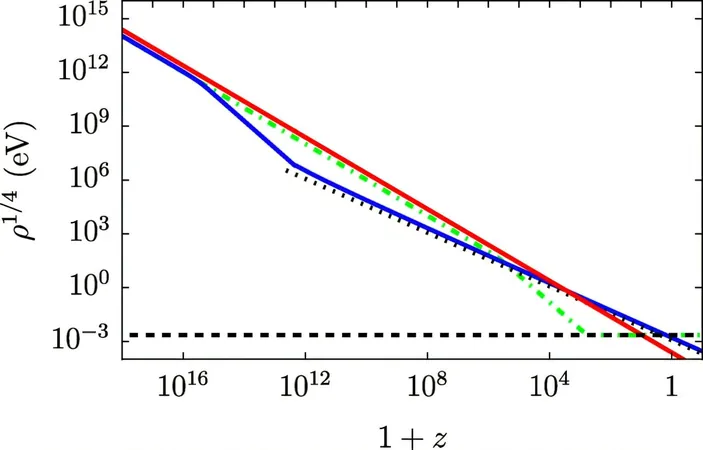
Revolutionary Theory Reveals How Dark Matter Could Have Formed From Speedy Particles!
2025-05-14
Author: Wei Ling
A New Twist in the Dark Matter Mystery
In a groundbreaking study, Dartmouth researchers have unveiled a fresh theory about the formation of dark matter, the elusive substance believed to shape our universe's structure. According to their findings published in *Physical Review Letters*, dark matter might have originated when incredibly fast particles slowed down, gaining significant mass much like steam condensing into water.
The Origins of Dark Matter Explained
Dark matter, thought to make up a staggering 85% of the universe, is inferred from gravitational forces that visible matter simply can't account for. This new theory stands out because it can be validated with existing observational data. The researchers propose that low-energy particles, which potentially make up dark matter, would leave a distinct imprint on the cosmic microwave background (CMB)—the faint radiation left over from the Big Bang, filling our vast universe.
From Light to Heavy: The Transformation of Particles
"Dark matter began as nearly massless particles, much like light itself," explains Robert Caldwell, the study's senior author and a professor of physics and astronomy. This assertion contradicts the traditional understanding of dark matter as cold, massive clumps that give galaxies their weight. Instead, Caldwell's theory proposes a fascinating transition from light-speed particles to dense formations.
The Big Bang and Particle Collision
Following the Big Bang—an explosive event marking the universe's inception around 13.7 billion years ago—hot, rapidly moving particles dominated the cosmos. These particles, akin to photons, exhibited incredible energy. Amid the early chaos, many began to pair up due to their opposing spins, similar to how magnets attract, setting the stage for the eventual formation of dark matter.
Cooling Down: The Key to Mass Accumulation
As these particles cooled, Caldwell and first author Guanming Liang suggest that imbalances in their spins led to a dramatic energy drop—akin to steam rapidly condensing into water. This energy plummet yielded the cold, heavy particles theorized to constitute dark matter today. Liang notes, "The unexpected part of our model was the striking energy decrease that bridges the high-density universe of the past and the lumpy, cooler particles we see now."
Linking Cooper Pairs to Dark Matter Formation
The researchers theorize that a specific type of particle may facilitate this transition. They draw parallels to electrons, which can form Cooper pairs at low temperatures—these pairs allow electricity to flow without resistance in superconductors. The existence of Cooper pairs hints at a potential mechanism for the massless particles in their model to coalesce into dark matter.
Connecting the Dots: Energy and Mass Density in the Universe
The research also sheds light on the ongoing paradox of energy density decline since the Big Bang while accounting for increasing mass density. "Cold dark matter structures must have a mechanism to ensure energy density drops close to current observations," Liang elaborates.
Exciting Prospects for Future Research
Their theory proposes that as particle pairs began to slow down, they entered a cold, nearly pressureless state that could be identifiable in the CMB. Large-scale observational efforts, like the Simons Observatory in Chile, could verify Caldwell and Liang's predictions, opening new avenues in the hunt for dark matter.
"The potential to rethink how we understand dark matter is thrilling," Caldwell concludes. This innovative approach offers a glimmer of hope for identifying one of the universe's biggest mysteries.

 Brasil (PT)
Brasil (PT)
 Canada (EN)
Canada (EN)
 Chile (ES)
Chile (ES)
 Česko (CS)
Česko (CS)
 대한민국 (KO)
대한민국 (KO)
 España (ES)
España (ES)
 France (FR)
France (FR)
 Hong Kong (EN)
Hong Kong (EN)
 Italia (IT)
Italia (IT)
 日本 (JA)
日本 (JA)
 Magyarország (HU)
Magyarország (HU)
 Norge (NO)
Norge (NO)
 Polska (PL)
Polska (PL)
 Schweiz (DE)
Schweiz (DE)
 Singapore (EN)
Singapore (EN)
 Sverige (SV)
Sverige (SV)
 Suomi (FI)
Suomi (FI)
 Türkiye (TR)
Türkiye (TR)
 الإمارات العربية المتحدة (AR)
الإمارات العربية المتحدة (AR)